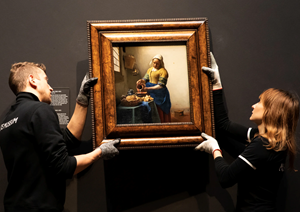
Rijksmuseum, the Netherlands’ national museum of art and history, opens its exhibition Vermeer to the public this coming Friday, 10 February. This will be the first retrospective exhibition of Johannes Vermeer in the history of the Rijksmuseum.
Rijksmuseum, the Netherlands’ national museum of art and history, opens its exhibition Vermeer to the public this coming Friday, 10 February. This will be the first retrospective exhibition of Johannes Vermeer in the history of the Rijksmuseum.
The 28 Vermeer paintings in this show – from seven countries around the world – make this the most complete overview of his work ever mounted. Seven of the paintings will be on view in the Netherlands for the first time in over 200 years. In the run-up to the exhibition, extensive research has been conducted in close collaboration with the Mauritshuis in The Hague. The exhibition explores the artist’s ambitions, work, private life, religious faith and social milieu.
The 28 Vermeer paintings are presented in a spacious setting that spans all ten galleries of the museum’s Phillips Wing. In 11 thematic sections, the exhibition brings visitors closer to Vermeer and offers rich insights into the life and paintings of Vermeer, including: early ambitions, first domestic interiors, balance between the indoor and outdoor worlds, the letters, musical seduction, outlook on the world and inner values.
The exhibition is designed by the French architect and designer Jean-Michel Wilmotte. The velvet décor of the exhibition in intense green, aubergine and blue draws from Vermeer’s signature compositions. Graphic design for the exhibition is by Irma Boom.
Vermeer is Rijksmuseum’s first ever comprehensive exhibition of Johannes Vermeer’s work. The only previous monographic Vermeer exhibition ran from 1995 to 1996 and was mounted by the National Gallery of Art in Washington and Mauritshuis in The Hague. For nearly three decades, it was considered beyond the realms of possibility that another show of this calibre devoted entirely to the work of Vermeer would ever be held again. All museums holding Vermeer paintings regard them as the absolute pinnacle of their collection, and for this reason rarely lend them to other museums. It is unprecedented, then, that the Frick Collection has loaned for display outside New York its three Vermeer masterpieces: Mistress and Maid; Girl, Interrupted at Her Music; and Officer and Laughing Girl. The exhibition includes a total of 28 paintings from 14 museums and private collections from 7 countries.
The latest research has unearthed new sources that shed light on the painter and his personal circumstances. As a result, we know more about his social position, his living environment and his contacts with artists and fellow citizens.
Technical research
Modern scanning techniques have accelerated research into Vermeer over the past decades. A team of curators, conservators and scientists from the Rijksmuseum have been collaborating closely with colleagues from the Mauritshuis in The Hague and the University of Antwerp to conduct new research into Vermeer’s paintings. The techniques used for this investigation include the advanced Macro-XRF and RIS scanning technologies. Several sensational changes that Vermeer made to paintings such as The Milkmaid have recently come to light, offering new insights into his approach, artistic process and search for the perfect composition.
Research into the paintings will continue during and following the exhibition. The results of these investigations will be presented at an international symposium at the Rijksmuseum in 2025 (350 years after the death of Johannes Vermeer). The symposium will also present research conducted in other museums, including the National Gallery in Washington and the Mauritshuis in The Hague.
Faith, light and reflection
Recent art historical research has shed new light on the influence of Delft’s Catholic Jesuit order on Johannes Vermeer, who had a Protestant upbringing. Their influence was greater than previously believed. Among other things, the research produced credible evidence that it was through his contact with the Jesuits that Vermeer encountered the camera obscura. This device made it possible to project the light from a three-dimensional scene onto a wall or screen where it could be studied in two dimensions. The research also establishes what a major influence Catholicism had within Vermeer’s household and family, and that this influence is reflected in his work.
Johannes Vermeer
Johannes Vermeer (1632-1675) lived and worked in Delft. Vermeer grew up surrounded by his art-dealer father’s business, and he was raised a Calvinist reformed Protestant. Upon his marriage, however, he became part of a Catholic family. We know that he had 14 or 15 children, and that 11 of them survived beyond childhood. As well as being a painter, Vermeer was an art dealer and the head of the St Lucas artists’ guild. His work is best known for his tranquil, introverted interior scenes, his unprecedented use of bright, colourful light and his convincing illusionism. In contrast to Rembrandt, Vermeer left a remarkably small oeuvre of 37 paintings. Seven Vermeer paintings have a permanent home in the Netherlands: four at the Rijksmuseum, including The Milkmaid and The Little Street; and three at the Mauritshuis, including Girl with a Pearl Earring.

ArtDependence Magazine is an international magazine covering all spheres of contemporary art, as well as modern and classical art.
ArtDependence features the latest art news, highlighting interviews with today’s most influential artists, galleries, curators, collectors, fair directors and individuals at the axis of the arts.
The magazine also covers series of articles and reviews on critical art events, new publications and other foremost happenings in the art world.
If you would like to submit events or editorial content to ArtDependence Magazine, please feel free to reach the magazine via the contact page.